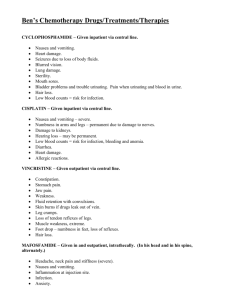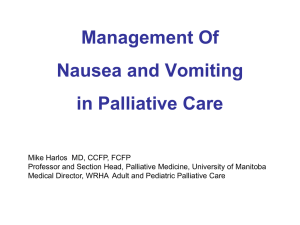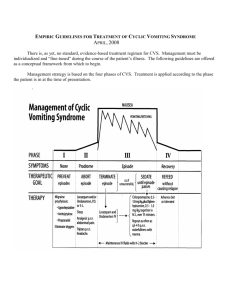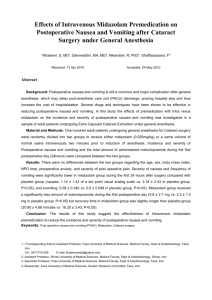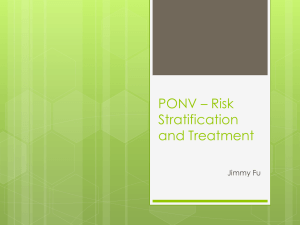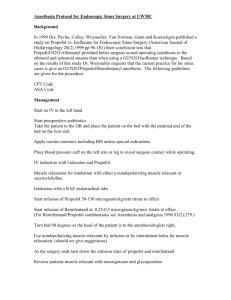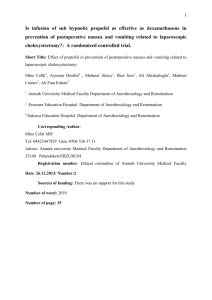ketofol - universal journals publication
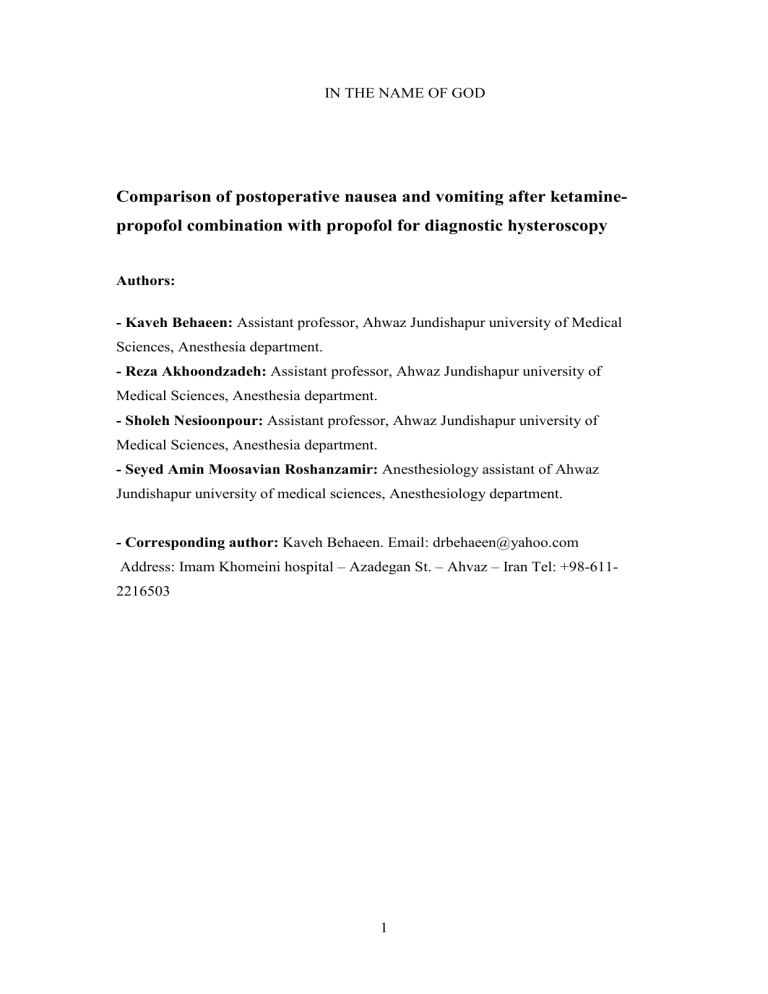
IN THE NAME OF GOD
Comparison of postoperative nausea and vomiting after ketaminepropofol combination with propofol for diagnostic hysteroscopy
Authors:
2216503
- Kaveh Behaeen: Assistant professor, Ahwaz Jundishapur university of Medical
Sciences, Anesthesia department.
- Reza Akhoondzadeh: Assistant professor, Ahwaz Jundishapur university of
Medical Sciences, Anesthesia department.
- Sholeh Nesioonpour: Assistant professor, Ahwaz Jundishapur university of
Medical Sciences, Anesthesia department.
- Seyed Amin Moosavian Roshanzamir: Anesthesiology assistant of Ahwaz
Jundishapur university of medical sciences, Anesthesiology department.
- Corresponding author: Kaveh Behaeen. Email: drbehaeen@yahoo.com
Address: Imam Khomeini hospital – Azadegan St. – Ahvaz – Iran Tel: +98-611-
1
Abstract:
Introduction: Postoperative nausea and vomiting is one of the complications after diagnostic hysteroscopy. We compared incidence of nausea and vomiting after diagnostic hysteroscopy with two techniques for sedation one Ketofol (Ketamine-
Propofol combination) and other Propofol during operation.
Methods: In a double blind clinical trial patients were divided into two groups
(n=20). One group was sedated with propofol and the other received ketofol.
Incidence of nausea and vomiting were compared in both groups.
Results: Demographics and vital signs were the same before induction in two groups.
There were no significant differences about nausea and vomiting between two groups
(P value˃ 0.5).
Conclusion: Incidence of nausea and vomiting with propofol and ketofol (ketaminepropofol) for sedation in diagnostic hysteroscopy are low and did not have any significant difference between two techniques.
Keywords: Ketamine – Ketofol – Nausea - Propofol - Vomiting
2
Introduction:
Postoperative nausea and vomiting (PONV) is one of the complications after anesthesia and surgery
1, 2
.
PONV occurs in approximately 30% of all patients undergoing general anesthesia
3, 4
. The incidence of PONV is influenced by various patient related factors, type of surgery, anesthesia technique and postoperative factors such as pain, use of opioids for pain relief, dizziness and ambulation
5, 6
.
Diagnostic hysteroscopy is a commonly performed gynecologic procedure to evaluate the endocervical canal, endometrial cavity, and tubal ostia. It is a useful procedure to evaluate women with infertility. PONV is one of the complications after this procedure. Different kind of pharmacological and non-pharmacological management has been proposed for postoperative nausea and vo miting
7 10
.
Many anesthetic options are available to patients undergoing hysteroscopy. There has been an increasing interest to a combination of ketamine and propofol (ketofol) in recent years. It seems that ketamine increases blood pressure and attenuates hemodynamic effects of propofol. The other point is that propofol has the antiemetic and strong sedative effects thus reducing the psychiatric adverse effects of ketamine. In this study we evaluated nausea and vomiting after diagnostic hysteroscopy for infertility investigations with two techniques for sedation one Ketofol (Ketamine-
Propofol combination) and other Propofol during operation.
Material and Methods:
This study was approved with the institutional ethics committee. In a randomized, double -blind, prospective study, Forty Patients were divided into two groups (n=20).
Before anesthetic induction, standard monitoring including electrocardiogram, pulse oximetry and noninvasive blood pressure monitoring was applied to all patients in the operating room. Crystalloid solution was infused at a rate of 5 ml/kg. Patients were randomly assigned to propofol or ketamine-propofol group with sealed envelope technique. Patients were pre-oxygenated with 100% oxygen for 5 min, just before anesthesia induction. Both groups received 1μg/kg fentanyl infusion. After five minutes Propofol 0.2ml/kg (5 mg/ml in a 20-ml syringe), or ketamine-propofol
0.2ml/kg (1:1 mixture of ketamine 10 mg/ml and propofol 10 mg/ml mixed in a 20-ml syringe) was administered slowly. After 90 seconds patients were evaluated to determine the degree of sedation and additional propofol or ketamine-propofol
3
combination were given in 0.1ml/kg increments until the patients sedation score reached to number 6 based on ramsay sedation scoring (table1).
Vital signs and BIS (Bispesteral Index Score) were recorded before induction and after the patients sedated to a Ramsey Sedation Score of 6. Vital signs, side effects & duration of recovery were compared in both groups.
Patients and nurses were informed that an antiemetic should be given in the presence of intolerable nausea or vomiting. Both patients and nurses were unaware of patient group allocation. The incidence of nausea and vomiting during the first 24 h was determined. The results were scored in a manner similar to that of Allen, Kitching and
Nagle
11 as none, nausea, retching/vomiting. If a patient experienced both nausea and vomiting, they were recorded as having vomiting. To examine the severity of nausea and vomiting, nausea was classified as none, mild and moderate or severe.
The parametric data of the patients were compared using the student t-test for the continuous variables and the chi-square test for the categorical variables. A P-value <
0.05 was considered significant.
Results and Discussion:
Both groups didn’t have any significant difference in mean of age (P value = 0.52) and vital signs before induction of sedation (P value = 0.28). Both groups didn’t have any significant difference in systolic blood pressure ( P value = 0.83 ), heart rate (P value = 0.75), End Tidal CO2 (P value = 0.57) and BIS (P value = 0.29) before and after five minutes reaching to number 6 ramsay sedation scoring (table2).
Both groups didn’t have any significant difference in time of operation (P value =
0.83). But recovery time was longer in the ketofol group (P value = 0.008). There was not any nausea or vomiting in the propofol group. One patient in the ketofol group had nausea and vomiting. The operation time in that patient was longer than other patients (40 minutes). She received 150 mg ketamine during operation (P value =
0.5). In our study incidence of nausea and vomiting within 24 hours after operations did not have any significant difference in the both groups. The results of our study indicate that the incidence of nausea and vomiting with these two techniques one propofol and the other ketofol (ketamine-propofol) for sedation in diagnostic hysteroscopy are negligible and did not have any significant difference between two techniques.
4
Conclusion: The incidence of nausea and vomiting with propofol and ketofol
(ketamine-propofol) for sedation in diagnostic hysteroscopy are low and did not have any significant difference between two techniques.
Acknowledgment: This paper is issued from thesis of Seyed Amin Moosavian
Roshanzamir and financial support was provided by Ahvaz Jundishapur University of
Medical Sciences. We are indebted to all physicians, staff and patients who participated in this study.
References:
1. Shaw PJ, Bates D, Cartlidge NEF, et al: Neurologic and neuropsychological
Morbidity following major surgery: comparison of Coronary artery bypass and peripheral vascular surgery. Stroke. 1987; 18:700–707.
2.Shaw PJ, Bates D, Cartledge N. Early neurological complications of coronary artery bypass surgery. Br Med J. 1985; 291: 1384–1387.
3.Roach G, Kanchuger M, Mangano CM, et al. Adverse outcomes after coronary bypass surgery. Multicenter Study of Perioperative Ischemia Research Group and the
Ischemia Research and Education Foundation Investigators. New England Journal of
Medicine. 1996; 335:1857-1863.
4.Llinas R, Barbut D, Caplan LR. Neurologic complications of cardiac surgery. Prog
Cardiovasc Dis. 2000; 43(2):101-112.
5. Barbut D, Caplan LR. Brain complications of cardiac surgery. Curr Probl Cardiol.
1997; 22(9):449-480.
6.Bucerius J, Gummert JF, Borger MA, et al. Stroke after cardiac surgery: a risk factor analysis of 16184 consecutive patients. Ann Thorac Surg. 2003; 75(2):472-478.
7. Soltanzadeh M, Behaeen K, Pourmehdi Z. Safarimohsenabadi A. Effects of acupressure on nausea and vomiting after gynecological laparoscopy surgery for infertility investigations. Life Sci J 2012;9(3):871-875
5
8. Liberman MA, Howe S, Lane M. Ondansetron versus placebo for prophylaxis of nausea and vomiting in patients undergoing ambulatory laparoscopic cholecystectomy. Am J Surg. 2000; 179(1): 60–62.
9. Bailey PL, Streisand JB, Pace NL,Bubbers SJ, East KA, Mulder S, et al.
Transdermal scopolamine reduces nausea and vomiting after outpatient laparoscopy.
Anesthesiology. 1990; 72(6): 977–980.
10. Ferrari LR, Donlon JV. Metoclopramide reduces the incidence of vomiting after tonsillectomy in children. Anesth Analg. 1992; 75(3): 351–354.
11. Allen D L, Kitching A J, Nagle C. P6 acupressure and nausea and vomiting after gynaecological surgery. Anaesthesia and intensive care. 1994; 22(6): 691-693.
6
Table1: Ramsay sedation scoring
Patient condition
Nervous, agitated, and/or restless
Cooperative, orientated, quite patient
Only obeying the orders
Sleeping, hitting the glabella, and responding to high voice suddenly
Score
1
2
3
4
Sleeping, hitting the glabella, and responding to high voice slowly
5
No response to any of these stimulations 6
Table2: Changes in blood pressure, heart rate, ETCO2 and BIS before sedation and 5 minutes after sedation
Parameter
Systolic blood
Propofol group
10.85±8.16
Ketofol group
6.4±6.75
P value
P˃0.05
pressure
Heart rate
ETCO2
BIS
17.05±10.64
0.7±5.8
30.95±9.97
20.3±10.4
0.4±3.4
27.8±6.55
P˃0.05
P˃0.05
P˃0.05
Abbreviation: ETCO2=End Tidal CO2; BIS= Bispesteral Index Score
7

